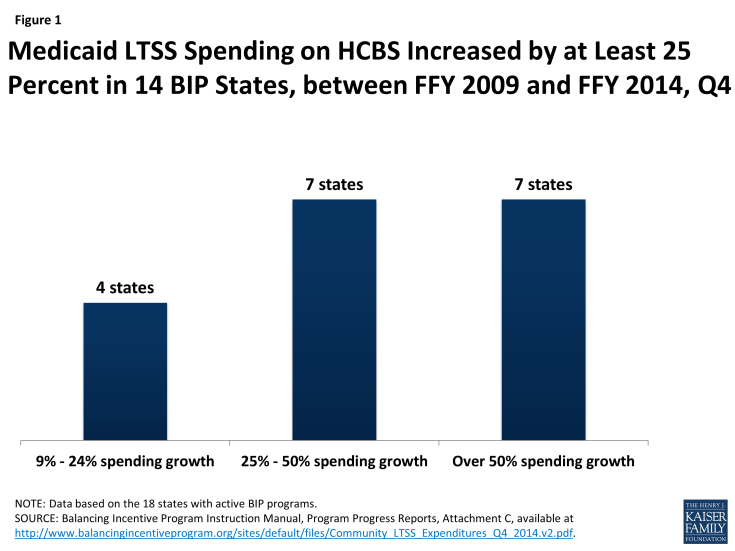Medicaid Balancing Incentive Program: A Survey of Participating States
Eighteen states are currently participating in the Medicaid Balancing Incentive Program (BIP) to increase access to home and community-based services (HCBS) as an alternative to institutional care. Established by the Affordable Care Act, BIP authorizes $3 billion in enhanced federal funding from October 2011 through September 2015. As a condition of participation in BIP, states must implement certain structural changes and reach specific financial benchmarks by September 2015, spending at least 25 percent (1 state) or 50 percent (the remainder of states) of their total Medicaid long-term services and supports (LTSS) dollars on HCBS. During the summer of 2014, the Kaiser Family Foundation’s Commission on Medicaid and the Uninsured surveyed BIP states about basic program information, progress with implementing the BIP structural requirements, stakeholder engagement, evaluation activities, and the use of enhanced federal funds in support of other Medicaid LTSS rebalancing efforts.
Key findings from the survey include the following:
- States report that BIP is helping them achieve their goal of rebalancing LTSS in favor of HCBS. Medicaid LTSS spending on HCBS increased in all 18 BIP states, with 14 states reporting spending growth of 25 percent or more between 2009 and 2014 (Figure 1).
- BIP is helping states make further progress in streamlining and standardizing the infrastructure that facilitates beneficiary access to HCBS by establishing a no wrong door/single entry point system, conflict-free case management, and a core standardized assessment.
- BIP supports LTSS rebalancing efforts by building on existing Medicaid HCBS options available to states. For example, seventeen states used BIP funds to expand Medicaid HCBS waivers by adding slots or services.
- States report some common challenges encountered to date related to measuring quality, coordinating with capitated managed LTSS delivery systems, and implementing the required structural reforms.
- While BIP has helped states make progress in LTSS rebalancing, the time-limited nature of the program creates some challenges and leaves open questions about its future.

Figure 1: Medicaid LTSS Spending on HCBS Increased by at Least 25 Percent in 14 BIP States, between FFY 2009 and FFY 2014, Q4
States are making progress under BIP towards a more unified person-centered LTSS system. The availability of enhanced funding is increasing access to HCBS, and BIP funds are creating the opportunity to build upon existing Medicaid LTSS rebalancing efforts already underway, including Money Follows the Person. The structural reform requirements are helping to streamline access to and information about LTSS and reduce administrative inefficiencies that existed in many states’ eligibility determination processes. Collectively, these system reform efforts are helping states reach a desired goal of serving Medicaid beneficiaries with LTSS needs in the most integrated setting. After BIP ends in September 2015, further work will be needed to maintain the costs of the structural changes and to monitor how they are working, particularly within the context of managed care delivery systems.


